Team-Building with Elementary Students
Yes, there are mounds of curricula students must master in a wide breadth of subjects, but education does not begin and end with a textbook or test. Other skills must be honed, too, not the least of which is how to get along with their peers and work well with others. This is not something that can be cultivated through rote memorization or with strategically placed posters. Students must be engaged and cooperation must be practiced, and often. (http://www.teachthought.com/critical-thinking/10-team-building-games-that-promote-critical-thinking/)
I meet with two groups of gifted elementary students, grades 2nd through 6th, for a full day each week. I begin our days together with a team building activity. The benefits for doing so cannot be overstated:
- It sets the climate that cooperation and collaboration is an expectation in the classroom.
- It reinforces that each person’s ideas and contribution will be respected.
- It’s whole body-mind learning.
- It builds a sense of classroom community which carries over through all of the classroom activities.
- Communication, listening, and problem-solving skills are developed and enhanced.
- Divergent thinking is honored and expected to successfully approach and complete the activities.
Lists and descriptions of team-building activities can be found at:
Several of the activities require some props. I enjoy making my own but they can also be purchased from the stores that sell sports goods to schools:
- https://www.palossports.com/store/prodpage3.cfm/CategoryID/30581/SubCatID/2807/file.htm
- http://www.ssww.com/sports-pe-recreation/team-building/
- http://www.flaghouse.com/General-Education/Cooperative-Play/
- http://www.flaghouse.com/General-Education/Project-Adventure/
Sample Team-Building Activities
Spaghetti-Marshmallow Tower
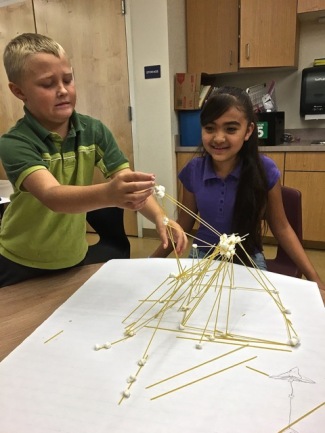
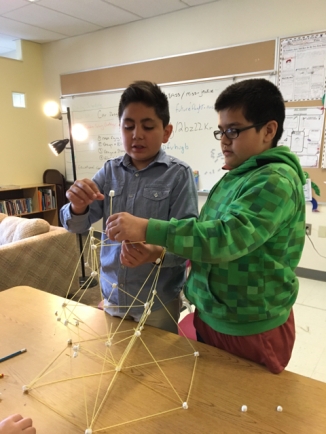
Materials:
- Mini-marshmallow
- Dry spaghetti
Task:
Split students into groups of 3 to 4 participants and given marshmallows and spaghetti (equal quantities of supplies per group). They are then given the task to only use the marshmallows and spaghetti to build the tallest tower.
Great Egg Drop
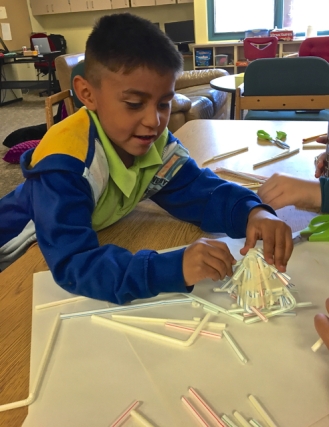
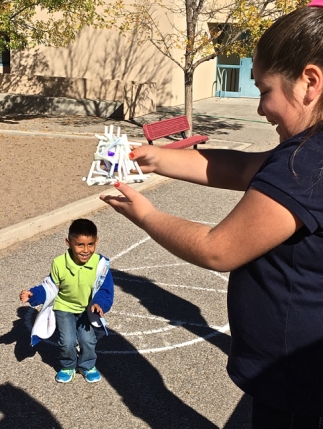
Materials:
- One egg per group
- 40 straws per group
- a few feet of masking tape – same amount
The Task:
Divide the group into small teams of 3 – 4. Give each team one raw egg, 40 straws, 1 meter of duck tape, and other materials as listed above. Tell them that the goal is to design and build a structure that will prevent their raw egg from breaking from a high drop (from the top of the playground structure.
Traveling Tangrams
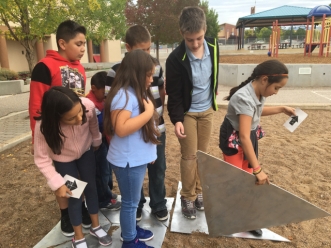
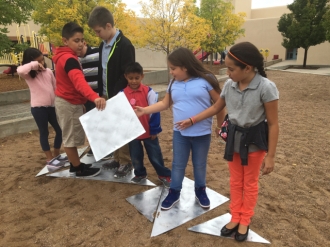
Materials:
- 7 pieces of a Tangram cut out of 4′ x 4′ piece of plywood
- print out of different Tangram shapes (e.g. see http://www.fun-stuff-to-do.com/tangrams.html)
The Task:
To begin, give all of the large Tangram pieces and a few copies of the specific Tangram shape that you want the students to create. As a group, they need to create that shape using all 7 pieces at the beginning of the crossing area/the beginning “shore of the river.” The rest of the activity is similar to the River Crossing team-building activity. The object of the activity is to get all members of the group safely across the river; a designated area 25 to 50 yards wide. They must go as one big group, not multiple smaller ones. Everyone must be on the river before anyone can get off the river, forcing the entire group to be engaged at once. Participants cannot touch the water (floor/grass) and therefore must use rafts (Tangram pieces) to cross. If one member does touch, the entire group must begin again. Once they reach the other side/shore, give them another Tangram shape to create and explain that they must stay on the pieces to form that shape. They can get off on the other side/shore once the Tangram shape is formed.
Copy the Structure
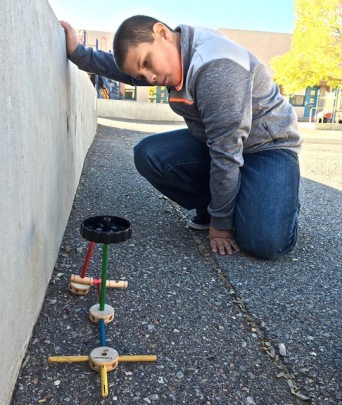
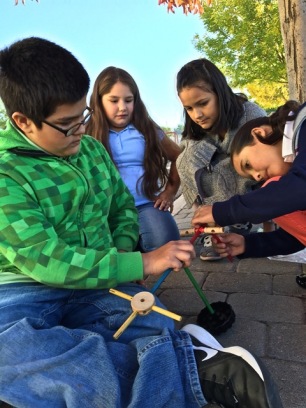
Materials: Several identical sets of Legos (or similar building bricks) that vary in size and color.
The Task:
Create a Lego structure out of different colored and sized Legos and place it somewhere in the room where it can’t be seen until the activity begins. Divide the group into smaller teams (depending on number of available Legos and size of the group). Each team should be given a set of bricks to build an exact copy of the Lego structure you have already built. The rules are that only one person from each team is allowed to go and have a look at the structure. When they come back to their team, they cannot touch the bricks, but they can tell the others how to build their copy. Anybody from the team can go and have a look, but only one at a time. Once another person comes back from having a look, the previous person can then touch their bricks to help build. Be sure to emphasize that the goal is for each team to complete an exact replica of the model.
Source: https://guideinc.org/2016/04/20/team-building-activity-lego-structure-copy/
Human Knot
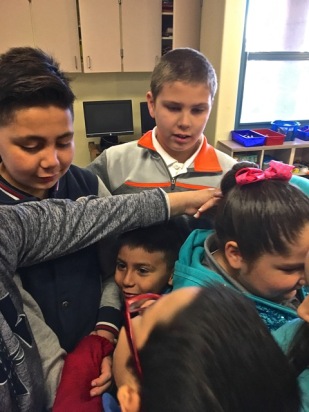
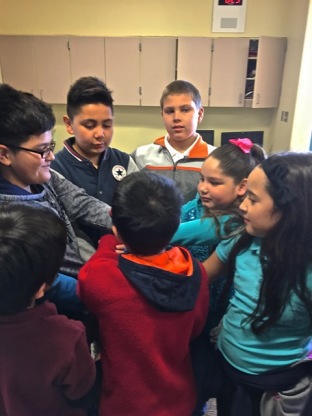
Materials: none
The Task:
Starting in a circle, students connect hands with two others people in the group to form the human knot – right hand to right hand; left hand to left hand; connecting with two different people. As a team they must then try to unravel the “human knot” forming into a untangled circle by untangling themselves without breaking the chain of hands.
Pipeline
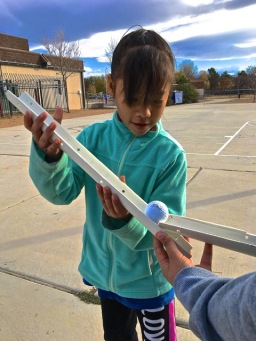
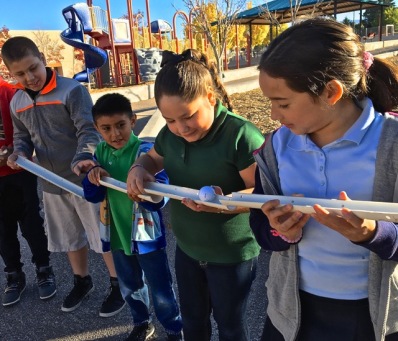
Materials:
- 1″ PVC pipe cut down the middle – a 18″ section per participant (pool noodles can be substituted)
- a golf ball
The Task:
Students, as a big group, are asked to work together to transport golf balls across a designated area through the chain of plastic tubes, lining them up and acting quickly so they don’t let the golf balls drop! That means that the first person in line must run to the end of the chain. A course can be set up ahead of time but I like to tell them the course as they go. If they are performing well, I ask them to go up, over, and through playground equipment. They can only touch the pipes not the balls. If a ball drops, the group must begin again. Once the marbles pass through their tube, kids have to move to the end of the line to keep the flow going.
Pinball Tarp Machine
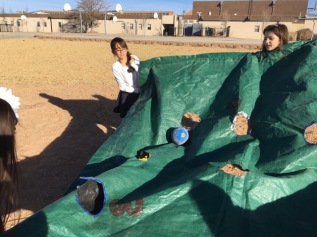
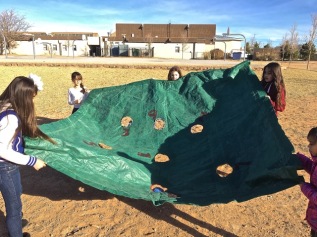
Materials:
- One tarpaulin is cut randomly with 8 to 10 holes and numbered from 1 through 8-10 depending on how many holes are cut (or two tarps if you want to have more than one group. I usually have two groups competing). The word START is written at one of the corners.
- Small playground ball – a little smaller than the cut holes
The Task:
Between 8 and 20 participants surround the tarp spacing themselves out evenly holding on to the tarp with both hands, creating a table top effect. Supply the groups with one small playground ball. Their goal is to get the ball to roll through the holes consecutively from 1 to 8 or 10. On each successful number, the ball is picked up from the ground and placed on START. If the ball falls off the tarp or through a hole, the group can start from the number where they left off or if a more difficult challenge is desired, the game starts over. If more than one group is playing, then the team that gets their ball through all of the holes first wins.
Catch the Foxtail
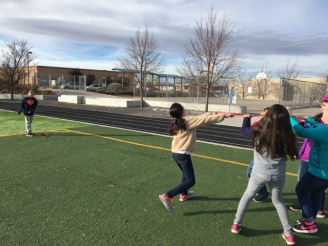
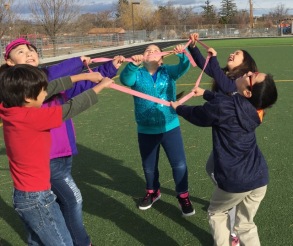
Materials:
- Foxtail balls – 3 per group (http://www.usgames.com/p-e-activities/toss-catch/foxtails)
- Rock climbing webbing – 5-6 foot diameter loop (like a hula hoop) for each groups (I like webbing because: (1) it is soft and pliable, and (2) it sits better in students’ hands. Ropes could cause rope burns)
The Task:
Split students into 5 or 6 participants per group. Each group is given three foxtail balls and a circle webbing. All members of that subgroup except for one student form a circle with the webbing so that the web forms into a big type of basketball hoop. The remaining member throws each of the foxtail balls one at a time up into the air. The task of the hoop holders is the try to get the balls through the hoop while all keep their two hands on the hoop. Getting the ball through the hoop after a bounce does not count. They often need to run together to get under the ball. After the three balls are thrown, the thrower switches places with one of the holders. All students should get a chance to throw the balls. The team with the most “baskets” wins.
Robot Drawing
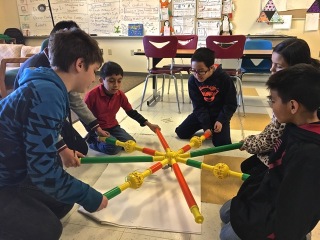
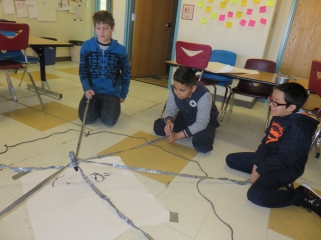
There are two versions:
- The Toobeez version – http://www.toobeez.com/teambuilding-book/17-Robot-Writer-Activity.html
- The Duct Tape version – http://groupdynamix.com/ducttapegame/
Toxic Waste
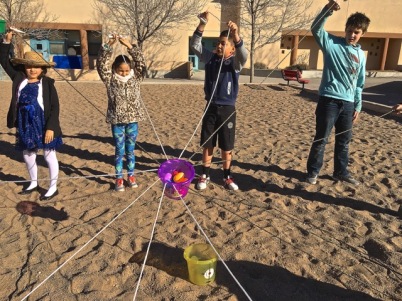
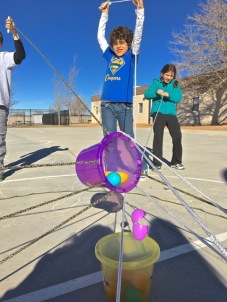
Materials:
- two plastic bucket, one with 8′ ropes tied into it (I drill holes in the side and tied the end of nylon ropes through the holes – one per participant)
- plastic balls
- another piece of rope tied together to create a loop with a 8′ diameter – this acts as a boundary
- a much more expensive version can be purchased – http://everlastclimbing.com/products/toxic-waste-transfer/
The Task:
- Set Up – Set up the 8′ rope circle. Put the plastic balls into the bucket with the ropes. Put the other bucket next to it.
- Situation to Tell Students – A bucket of highly toxic popcorn (the plastic balls) has contaminated a circle approximately 8 feet in diameter. The toxic area extends to the sky (meaning that hands and arms cannot cross into the area. If the poisonous popcorn is not transferred to a safe container (the other bucket) for decontamination, the toxic popcorn will contaminate and destroy the population of the entire city.
- The Task – You must find a way to safely transfer the toxic popcorn from the
unsafe container to the safe container, using only the materials provided to you. Each student must always hold onto the end of his or her rope.
Written by Jackie Gerstein, Ed.D.
March 6, 2017 at 11:57 pm
Posted in Education
Tagged with communication, group initiatives, problem-solving, SEL, social-emotional learning, team building
4 Responses
Subscribe to comments with RSS.
Leave a comment Cancel reply
This site uses Akismet to reduce spam. Learn how your comment data is processed.

I love the human knot we tried that with preps but I think many wrre too young so ideally first grade or above
Naturelovers
March 7, 2017 at 12:04 am
yes – I did it with my elementary students quite late in the year so they could build trust with one another
Jackie Gerstein, Ed.D.
March 7, 2017 at 12:12 am
These are great games. I’ve played some similar, and some others. Games are a great way for building friendships and teams.
Norah Colvin
March 7, 2017 at 11:32 am
Great game for team-building. This can be modified to Geometry learning activity
Siitmbiso Ncube
March 12, 2017 at 9:04 pm